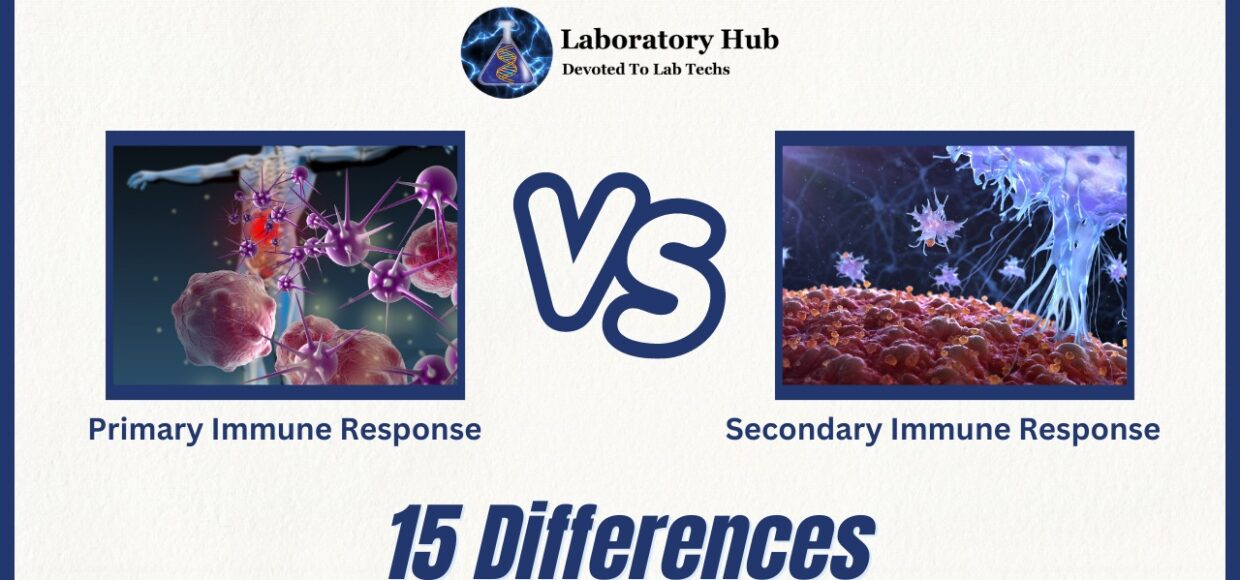Primary vs Secondary Immune Response- 15 Differences
The sophisticated immune system protects the body against infections. The immune system fights infections to restore health. Primary and secondary immunological responses characterize this reaction. Understanding the dynamics of immune defense requires understanding these reactions. This essay explains primary and secondary immune responses and their role in human health.
The first immune reaction to a disease or antigen is the main response. The immune system must detect and fight the virus on the initial encounter. B, T, and APCs are involved. APCs process pathogens and display tiny protein fragments on their cell surfaces as antigens. This presentation activates and proliferates particular T cells, which regulate and coordinate the immune response. B cells also release antibodies, which attach to and kill pathogens. The immune system needs many days to weeks to detect the infection, activate the right cells, and produce an adequate immunological response.
Reexposure to the same virus causes a secondary immune response. The immunological response is faster and stronger this time. The secondary immune response relies on the main immune response memory cells. The body has memory B and T cells that can detect and kill pathogens. These memory cells quickly and powerfully eliminate the infection. The secondary response boosts antibody synthesis, T cell activation, and immunological response, avoiding or lowering clinical symptoms.
Primary and secondary immune responses defend the body against infections differently. The initial response builds immune resistance, whereas the secondary response refines and amplifies subsequent exposures. Vaccination works by exposing the body to a harmless infection to start a basic immune response and generate memory cells. The immune system can then respond quickly and effectively to the virus.
In conclusion, the primary and secondary immune responses are distinct and help the body fight infections. The immune system’s memory powers the secondary reaction, which follows the original response. Understanding these phases improves immunology and helps create vaccines and treatments for infectious illnesses, providing a better and safer future for humanity.
S.No. | Category | Primary Immune Response | Secondary Immune Response |
1 | Occurrence | First encounter with a specific antigen. | Subsequent encounter with the same antigen. |
2 | Response Time | Slow response time, typically taking days to develop. | Rapid response time, often within hours. |
3 | Magnitude | Relatively lower antibody production. | More robust and higher antibody production. |
4 | Antibody Affinity | Lower antibody affinity for the antigen. | Higher antibody affinity for the antigen. |
5 | Memory Cells | Few memory B and T cells are generated. | Abundant memory B and T cells are present. |
6 | Antibody Classes | Initial production of IgM antibodies. | Increased production of IgG antibodies. |
7 | Isotype Switching | Isotype switching may not occur. | Isotype switching occurs, leading to production of IgG, IgA, or IgE antibodies. |
8 | Secondary Response Onset | Secondary response takes place after re-exposure to the antigen. | Rapid onset of the secondary response upon re-exposure to the same antigen. |
9 | Antibody Production Peak | Antibody production peaks around 1-2 weeks. | Antibody production peaks much earlier, usually within a few days. |
10 | Antigen Clearance | Clearance of the antigen may take longer. | More efficient and rapid clearance of the antigen. |
11 | Effector Cell Response | Initial effector cell response is less effective. | More potent and effective effector cell response. |
12 | Duration of Response | Primary response may be relatively short-lived. | Secondary response is longer-lasting and more sustained. |
13 | Immunological Memory | Immunological memory begins to develop. | Stronger immunological memory is established and maintained. |
14 | Protection | Primary response may provide some degree of protection. | Secondary response provides enhanced protection and can prevent reinfection. |
15 | Clinical Significance | Primary response is crucial for the initiation of adaptive immunity. | Secondary response plays a critical role in providing rapid and effective immune protection upon re-exposure to the same antigen. |
Also read: How to Prepare An Ideal Bacterial Smear ?
Frequently Asked Questions (FAQS):
The first immune response to a pathogen is the main immunological response. APCs recognize the pathogen, activate T and B cells, and produce antibodies. The immune system requires time to detect the infection, activate the right cells, and mount an efficient response.
Reexposure to the same virus causes a secondary immune response. It is quicker, stronger, and more efficient than the main reaction. Memory cells from the first reaction boost this response. Memory B and T cells immediately detect the virus and launch a strong immune response to eliminate it.
The initial immune response generates memory cells. They “remember” infections to speed up and improve immune responses. Memory B cells swiftly destroy the virus, whereas memory T cells efficiently detect and kill infected cells. Vaccines use memory cells for long-term immunity.
Primary immunological response takes many days to weeks. The response’s duration relies on the pathogen, antigen presentation, and immune cell activation and proliferation. The immune system identifies the infection, activates immune cells, and mounts an efficient response during this time.
Protecting against infectious microorganisms requires primary and secondary immune responses. The initial reaction starts antibody and immune cell synthesis. Memory cells produce the secondary response, which is fast and strong. Understanding these reactions helps design vaccines that use the immune system’s memory cells to provide long-term immunity and better protection against infectious illnesses.







